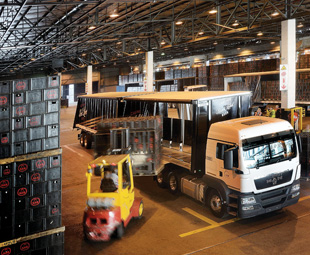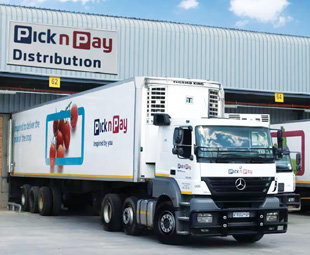Reliable transport a priority

Delivering food and beverage products to 302 stores in Gauteng can be an uphill battle, but reliable transport makes the job a lot easier. MARCEL TROUT finds out what it takes.
The food and beverage distribution business is highly demanding, requiring a strong work ethic and plenty of patience. Certainly, managing a fleet of 140 grocery distribution vehicles and 128 for perishables is not a job that can be learnt overnight, as I discovered during a recent visit to the Pick n Pay distribution centre, situated on 273 000m2 of land in Meadowdale, near Modderfontein.
Pick n Pay contracts Unitrans Freight and Logistics to handle all its onsite transport, warehousing and deliveries, while Unitrans Supply Chain Solutions designs, implements and operates supply chain and logistics solutions for customers. Services include transportation, warehousing, distribution, clearing and forwarding.
My guide for the morning was Frikkie Dreyer, operations manager for Unitrans. Dreyer took me through a typical day in which supermarkets across Gauteng – and in some cases, further afield – place product orders with the distribution centre. Depending on the size of the order and the distance it must travel, the warehouse will check, clean, refuel and load a truck before sending it on its delivery run.
 This centre, housing 75 000m2 of perishables and groceries alone, is responsible for most of the deliveries in Gauteng – covering 302 stores – and also delivers to Botswana and other countries north of our borders. Pick n Pay also has similar centres in Durban, Cape Town and Nelson Mandela Bay.
This centre, housing 75 000m2 of perishables and groceries alone, is responsible for most of the deliveries in Gauteng – covering 302 stores – and also delivers to Botswana and other countries north of our borders. Pick n Pay also has similar centres in Durban, Cape Town and Nelson Mandela Bay.
In any distribution operation there will always be challenges to overcome – and being located in the heart of Gauteng brings a number of special difficulties. “Traffic congestion makes it extremely difficult for our drivers,” says Dreyer. “Operating costs always prove to be the biggest challenge, but we manage our way around that. The new tolling system will also have a huge impact on fleet management and operating costs and we reckon it could increase some of our overheads by between 40% and 45%.”
Most of the truck manufacturers are represented in the distribution centre’s fleet, which comprises 46 MAN TGM 15.240 BLC-Cab 4×2 rigid freight carriers, several 6×4 UD460s, six Internationals and 25 Mercedes-Benz 6×2 truck tractors.
The centre has an in-house service and maintenance station to refuel and wash the vehicles. However, the bigger trucks in the fleet are sent to the respective manufacturers for servicing, as the workshop is not big enough to accommodate them.
Unitrans is responsible for 268 vehicles on both sides of the site, as well as for forklifts and other modes of warehouse transport and these vehicles are serviced at the in-house maintenance station
Unusually, the busiest time of the day is between 13:00 and 14:00 – lunch time for most people. Long queues of trucks wait to enter the site to be checked and loaded and personnel work in shifts that keep production steady.
I have seen what a tough business this is, ensuring that everything goes according to schedule at a distribution centre as big as a village. The employees at this Pick n Pay distribution centre definitely seem “inspired by us”.
Published by
Focus on Transport
focusmagsa



